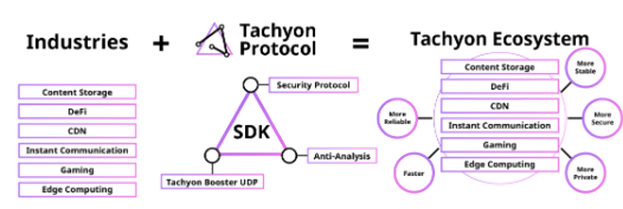$ 0.025 -6.65%
Orchid Protocol (OXT) Rank 1533
| Mkt.Cap | $ 25.4 M | Volume 24H | 8.73 MOXT |
| Market share | 0% | Total Supply | 0.00000000OXT |
| Proof type | N/A | Open | $ 0.03 |
| Low | $ 0.03 | High | $ 0.03 |
VPN Protocol Wars in the Blockchain World
Stakers stake their tokens to increase the likelihood that a given bandwidth provider will be selected. The VPN client starts by engaging with an Ethereum client that runs the selection routine for the nodes by running code present in OrchidDirectory. This step can remain fully trustless by asking the Ethereum client (which may be untrusted) for merkle proofs of the selected storage blocks (and the blocks themselves). This effectively makes OrchidDirectory.scan(), which performs the random weighted selection, more of a reference implementation than a fundamental part of the staking infrastructure. Orchid Labs was founded with a mission to create a more open and more accessible internet.
However, there are major differences between the two projects that set them apart. Tachyon Protocol is building an alternate stack to disrupt traditional communication protocols over the internet in order to eliminate drawbacks in TCP/IP.
It builds on several proven protocols to create easy access and secure communications for its users. It will reward users who provide nodes in the network for sharing their resources and bandwidth. To understand the Project’s approach to internet browsing, one should first be familiar with the way internet works. Current internet traffic is routed through central servers, through ISP or VPN.
It does so by incentivizing users to share bandwidth with others in a marketplace setting. This breaks up traffic and directs it over Orchid’s network of distributed nodes.
Like many other dedicated people around the world, the founders of Orchid Labs are fighting to end these practices and bring an open and liberated internet to everyone in the world. The Orchid protocol is their contribution to this movement for internet freedom—meaning internet that can’t be controlled by corporations or governments and is open and accessible to all.
6.1 Staking node can be inappropriately removed from the tree Critical ✓ Fixed

For verification, Orchid Protocol uses a stake weighting plan for nodes with staking time as the adjustable parameter. The initial staking period is set at 30 days, which is good for network security but increases the barrier to entry for user participation since they need to bear more opportunity costs from higher risks of price fluctuations. To solve this issue, Orchid lets nodes with higher/longer stakes to get more traffic.
The project has a particular focus on people who live in countries with excessive intrusion in browsing by the government. Orchid Protocol is a surveillance-free layer on top of the internet that enables secure and anonymous communication between users. This protocol is being developed as an open-source project by Orchid Labs. PURPOSE OF REPORTS The Reports and the analysis described therein are created solely for Clients and published with their consent.
No third party should rely on the Reports in any way, including for the purpose of making any decisions to buy or sell any token, product, service or other asset. CD owes no duty to any Third-Party by virtue of publishing these Reports. The way the Orchid network achieves true decentralization is by allowing anyone to join the network as a bandwidth provider and anyone to use the service as an end user. This permissionless environment is achievable with the usage of programmatic, probabilistic micropayments on top of Ethereum, the focus of this audit.

)--Orchid Labs Inc. has unveiled itself publicly today, along with the launch of the private alpha version of its Orchid Network accompanied by a whitepaper. The Orchid protocol is an open-source network intended to end internet surveillance and censorship, while protecting users’ personal data from being harvested by ISPs or other entities. Early in 2018, the blockchain-based Orchid network beta will launch to the public, enabling people across the world to freely communicate, collaborate, and access information.

Orchid Labs was founded in 2017 by Stephen Bell, Brian J. Fox, Gustav Simonsson, Dr. Steven Waterhouse, and Jay Freeman. Orchid is designed to give internet users an incentive to share their bandwidth with other users. By doing so, the protocol can break up traffic and route it through various nodes on the network, making it extremely difficult for an adversary to determine who is visiting the website, much as the TOR system works now.

6.7 In OrchidDirectory.step() and OrchidDirectory.lift(), use a signed amount Minor Won't Fix
The Reports are not an endorsement or indictment of any particular project or team, and the Reports do not guarantee the security of any particular project. This Report does not consider, and should not be interpreted as considering or having any bearing on, the potential economics of a token, token sale or any other product, service or other asset. Cryptographic tokens are emergent technologies and carry with them high levels of technical risk and uncertainty.

A random number is chosen by combining seeds from both the payer and the recipient. If that random number falls in a certain range (ratio in the code), the payment is transferred. Stakers – To mitigate certain kinds of attacks, the VPN software prefers bandwidth providers with more Orchid tokens (OXT) at stake.
OrchidDirectory keeps track of staked OXT tokens (Orchid’s native token). The staked amounts are held in a binary tree that allows for easy weighted random selection by clients. Orchid network is comprised of two main on-chain components, OrchidDirectory and OrchidLottery. They both play important roles in setting up the proper incentives for the correct functioning of the bandwidth market of the VPN product.
- The Orchid Protocol is an open-source project that aims to end Internet surveillance and censorship through Blockchain technology.
- After the traffic route is set up, clients need to be able to pay for packets of data as they’re being forwarded.
- WHYInternet access for over 75% of the global population is restricted or censored.
- The Orchid network protocol is built in such a way that the client should not need to trust the nodes that traffic is routed through.
- V Systems is a blockchain database cloud project that uses a unique Supernode-Proof-of-Stake consensus mechanism for security.

Even Australia is facing significant interference by the Government with regard to our open internet. To help provide counsel, Orchid Labs has enlisted a team of advisors with experience in cryptography and mission-driven projects. Users interested in updates about the progress of the protocol are encouraged to sign up for announcements about its beta release, on the Orchid website.
Orchid Protocol Token Distribution
Unfortunately, it’s no longer a place of true openness and freedom. We’ve created an open-source protocol with a token-based bandwidth exchange to protect everyone around the world from censorship and surveillance. We believe that by eliminating centralization, rewarding network contributors, and harnessing the power of blockchain, we can offer users better privacy. As users need to pay whenever they use the internet, the token usage is expected to be frequent.

The other concern with Tor is that it is now easy to identify Tor traffic on the network. Enterprises and entire countries can now block Tor traffic with ease. This has made Tor impossible to use in countries who could benefit from it the most, such as those behind the great firewall of China or countries affected by the Arab Spring a couple of years ago. There are add-ons and modules available which add some advanced features to Tor, but these are not standard, and rarely known by the average user. By preventing users from protecting their online activity, these countries can continue to restrict users access to an open internet.
Orchid Protocol Token Team

However, in its current state, the Ethereum chain is limited in terms of TPS (transactions per second) and hence leads to performance bottlenecks during times of high traffic. The Orchid Protocol acts as a layer on top of the normal Internet stackIn comparison, Tachyon Protocol’s approach has been to disrupt the core transmission protocols themselves, thereby providing a more comprehensive solution. It is reconstructing the TCP/IP model using its own iterations of proven P2P technologies – DHT, blockchain, UDP, and encryption. An open platform to access information, collaborate, and communicate freely across borders.
Orchid Protocol works on top of traditional internet protocols and creates a privacy layer using blockchain. This is done by using the open-source WebRTC for transmission to perform preliminary data obfuscation and multi-hop to reduce the chances of data theft.

X-VPN is a renowned VPN service provider used by 50 million + people worldwide. V Systems is a blockchain database cloud project that uses a unique Supernode-Proof-of-Stake consensus mechanism for security. Tachyon brings to fruition years of experience and research by Sunny King (inventor of Proof-of-Stake consensus mechanism), Peerchemist (Peercoin Project Leader, and President of the Peercoin Foundation) and FinTech investor Alex Yang.

ICO Analysis: Blockchain.IO (BCIO) Token
Orchid Labs is a company developing the open source Orchid protocol, which is a peer-to-peer network and online marketplace for selling and buying internet bandwidth. While their whitepaper goes into the technical details of the protocol, challenges and the competition; there is very little information about this project on social media. However, investments listed on their website do give an indication of the type of project this will be.
Similarly, multi-hop, while hiding original nodes, does not mask individual node activity in a P2P network. As a result, source nodes can be tracked using traffic analysis. For storage and routing, Orchid uses IPFS and Ethereum’s DHT, respectively.

As opposed to WebRTC, it uses its own Booster UDP to improve network connection success rates and transmission quality. The Tachyon Security Protocol is designed for end-to-end encryption and protocol imitation. With respect to multi-hop, the Tachyon Anti-analysis helps multi-relay forwarding to reduce the risk of information exposure after a single node is attacked.
Raising $120m for 20% of the project values it at a massive $600m. But consider that the VPN sector alone is expected to reach $106b by the year 2022 with a small concentration of nine organisations currently dominating this sector. The $600m valuation represents a little over half a percent of the expect market in 4 years. Should The Orchid Protocol manage to take even a small part of this market, that valuation appears extremely fair. It is a reasonable reflection of the project's current size and hasn't been inflated due to the team or potential market domination.





